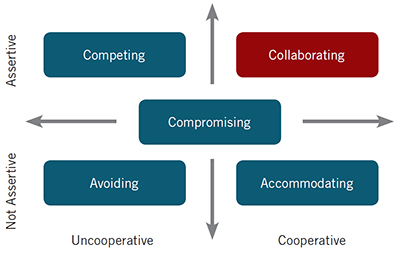The conflict management style you choose depends on the situation’s urgency and your long-term goals
By Tom Moriarty for Plant Services Magazine
Plant Services, November 12, 2018
Conflict in the workplace is very destructive. It makes people reluctant to work together. But what causes conflict? The simple answer is that conflict happens whenever two parties don’t see eye-to-eye.
During everyday activities, conflict comes from ambiguity, gaps, and overlaps in roles and responsibilities among individuals and work centers. If there is urgency, such as when production is disrupted because of equipment failure, conflict is generated by differences in objectives. Operations wants the system up immediately. Maintenance folks want time to repair the system so that it will not soon fail again.
How do you develop guidance or resolve conflict in a way that brings people and work centers together? The first thing to do is to understand conflict management styles. Conflict management styles can be thought of relative to their position on two dimensions.
The first dimension is the extent to which the first party is assertive and satisfies its own concerns. This is shown in the vertical axis in Figure 1. Toward the low end of the axis is a lack of assertion – ultimately, submissiveness. Toward the high end is assertion, and ultimately aggressiveness. The second dimension is the extent to which there is cooperation with the other party, represented by the horizontal axis.
Within the scope of the assertiveness and cooperation axes, there are five styles for conflict management:
- Collaborating – This style is high in assertiveness and high in cooperation. It emphasizes a win-win solution that gets the greatest satisfaction for both parties. It involves understanding conflict as healthy and normal. There must be a high level of trust among the parties involved. This is the preferred method for nonemergency conflict resolution.
- Compromising – This style attempts to achieve a win-win solution, but it likely will not achieve the greatest satisfaction for both parties. The style is useful when the parties have approximately equal power and value the objectives enough to work together for a good solution. This style is also good when there is a time constraint that requires a rapid resolution. Compromising can produce lose-lose or win-lose scenarios depending on the issue and the trust between the parties.

- Competing – This style is high on assertiveness and low on cooperation. This is commonly used for emergency situations or when an unpopular decision needs to be implemented. It’s asymmetric. The person with the power dominates the decision. Competing leads to win-lose outcomes. If used improperly, this style will increase conflict.
- Avoiding – This style is low on assertiveness and low on cooperation. The person withdraws from the conflict. It works best for situations where the issue is trivial, when others can resolve the conflict more effectively, or if there’s not much chance of having needs met. It is also used when a person believes the resolution will result in significant disruption; that person then “slow-walks” the resolution. Avoiding creates lose-lose outcomes.
- Accommodating – This style is low on assertiveness and high on cooperation. The person suppresses his or her own needs and works toward giving the other entity what it needs. This style creates lose-win outcomes and can be used to smooth over conflict. In the short term, accommodating can keep harmony and stability, but suppressed needs will eventually result in conflict down the road.
Contact Tom to ask about the two-day Productive Leadership Workshop; tjmpe@alidade-mer.com or (321) 961-4306.


















